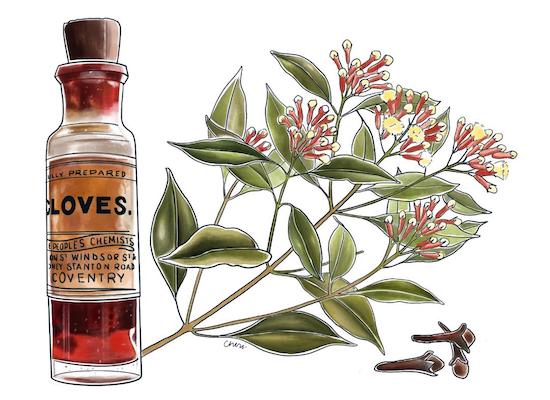Mention Cloves, and for me, it is the fragrance of hot steaming rice, exotic tea cakes from faraway lands, bubbling stews, curries, cool mocktails, and heady cocktails. My mind then wanders on to Chinese five-spice, Garam masala, and warm drinks like spicy mulled wine, apple cider, and good ole chai.
So what are the other culinary uses of cloves?
The Sanskrit word for clove is Laung and Ayurveda recommends it to be used especially during winter in food to increase one’s digestive fire.
Used sparingly in most recipes, cloves are used in sweet and savoury dishes and drinks as a flavouring agent. This pungent, dark, numbing spice adds warmth to pickling liquids, sweet chutneys, and jams. It is the main ingredient to Worcestershire sauce and is also used to make ketchup.
Often added to spice blends for meat rubs, marinades, and barbecue sauces it is also used to spice cookies and gingerbread. It is that familiar hum to pumpkin pie, roasted pumpkin, stuffings, and warm rice puddings. Cloves are also a big part of traditional food like Vietnamese poh and German red cabbage. They add depth to sweet warm winter desserts like stewed apples, rhubarb, and pears.
At home, we use clove oil diluted in a little water on our kitchen counters as a natural cleaner and to deter pests. We also burn the essential oil and use it as an air freshener. You will often find cloves are used for both their fragrance and anti-inflammatory properties in many products like toothpaste, mouthwash, oils, soaps, etc.
The story of cloves.
The English name for cloves is derived from the Latin word Clavus which means nail also known as clou by the French.
Originally cloves were mainly grown only on the then ‘Spice Islands’, (in Indonesia) also know as Moluccas. Many wars were fought over this pungent, and intensely flavoured spice. The Dutch did everything in their power to continue their monopoly over the clove market for money and profit to the extreme that they burnt down every clove tree that didn’t grow on Dutch-controlled spice islands.

 Fr. Warner D'Souza is a Catholic priest of the Archdiocese of Bombay. He has served in the parishes of St Michael's (Mahim), St Paul's (Dadar East), Our Lady of Mount Carmel, (Bandra), a ten year stint as priest-in-charge at St Jude Church (Malad East) and at present is the Parish Priest at St Stephen's Church (Cumballa Hill). He is also the Director of the Archdiocesan Heritage Museum and is the co-ordinator of the Committee for the Promotion and Preservation of the Artistic and Historic Patrimony of the Church.
Fr. Warner D'Souza is a Catholic priest of the Archdiocese of Bombay. He has served in the parishes of St Michael's (Mahim), St Paul's (Dadar East), Our Lady of Mount Carmel, (Bandra), a ten year stint as priest-in-charge at St Jude Church (Malad East) and at present is the Parish Priest at St Stephen's Church (Cumballa Hill). He is also the Director of the Archdiocesan Heritage Museum and is the co-ordinator of the Committee for the Promotion and Preservation of the Artistic and Historic Patrimony of the Church.
So very informative! And thank you for once again taking us one a journey of the senses. Each time you write something I can smell and taste the essence of it. Keep writing such beautiful articles. I feel another book will be published soon!
My fondest memory of cloves is Amma stewing apples in cinnamon and cloves for us when we were ill. That smell and the flavour was enough to drive the fever away! And also motivated us to eat something warm and comforting. Whenever I am ill now, along with soup, khichdi and kanji this is my go to meal. 🙂